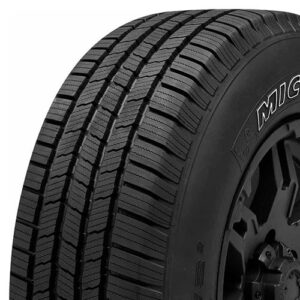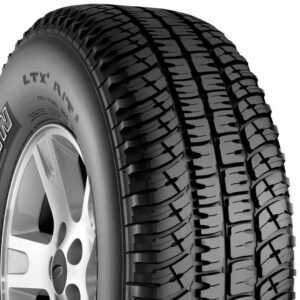Best Load Range E Tires
There are numerous different and excellent Load Range E (10-ply) tires and choosing the best one for you depends on a few important factors. Perhaps the biggest decision is picking how much off-road capability you need versus off-road grip. To that end, we’ve compiled a list below of the best Load Range E tires for your rig.
Best All-Season Load Range E Tires
Michelin Defender LTX MS
One of the most versatile truck tires on the market, the Michelin Defender LTX MS is one of the very best all-season tires regardless of if you need a load Range E option or not. Thankfully it comes in an impressive selection of load range E sizes.
The tread is impressively durable and holds up extremely well under hard use and heavy loads. Michelin also gos to great length to make sure its tire perform just as well when worn as when new, so even after 10s of thousands of miles you’ll still be impressed.
Plus it’s heavy siping mans it offers great grip in the wet and even well above average grip in the snow.
Best Off-Road Load Range E Tires
Goodyear Wrangler DuraTrac
If you need to tow heavy loads off road then our top pick is definitely the Goodyear Wrangler DuraTrac.
While some tires make a lot of concessions to on-road noise levels and comfort, the DuraTrac is committed to offering maximum grip and durability off-road and is a tire that’s relied upon by those who work off-road.
The tread is extremely aggressive with a mix of all-terrain and mud-terrain features, offering plenty of traction on low grip surfaces, loose earth and mud, thanks to a plentiful amount of void space between the tread lugs.
The tires sidewall construction is only 2-ply, however, the unique tread elements on the side of the tire do offer some additional protection.
One of the particularly unique features of this tire is that the tread base actually features a coarse traction surface to help with additional grip.
Best Off-Road Load Range E Tires (runner up)
Michelin LTX AT2
If you’re looking for off-road grip but don’t want to fully compromise on civility, the Michelin LTX AT2 all-terrain tire is a suitable option.
It’s not as extreme an off-road tire as some, but it is plenty durable and built to last a long time, especially when driven on gravel roads. In fact, Michelin claims it will last up to 35% longer than two main rivals.
On-road performance is better than most, especially in the wet.
If there is a drawback it’s that the LTX AT2 doesn’t come in as wide a selection of sizes as you might hope for.
Best Highway Terrain Load Range E Tires
Firestone Transforce HT2
For on-road towing with some off-road capability, the Firestone Transforce HT2 is a solid option with plenty of 10-ply fitments.
Civilized on-road while offering some off-road grip for occasional use, it holds up incredibly well under heavy loads.
It’s rated quite highly for wet weather grip, although winter grip is quite poor overall.
We don’t love that it comes with no specific milage warranty from the factory, however, you can expect roughly 55,000 miles under heavy use.
Pricing is attractive.
Best Budget Load Range E Tires
Kumho Road Venture APT KL51
If price is higher on your list of priorities for a set of Load Range E tires then this budget option has some highs and some lows.
Ride comfort is quite impressive and owners report being thrilled with just how great this tire is when towing on the highway.
On the flip side, it does wear reasonably fast and so we do recommend it for those who don’t put as many miles on their trucks.
We also caution that it seems an abnormal number of owners report bulges in the tread resulting from broken or slipped belts, so while you might save up front on this tire, it could be more hassle than it’s worth.
What are Load Range E tires?
Load Range E tires are sometimes referred to as 10-ply tires. It used to be that a tire’s ability to carry additional weight was dependant upon the actual number of plies in the tire casing and so a tire with 10 plies was suitable for towing heavy loads. Developments in tire technology mean that a tire can now have fewer plies but still meet that same level of towing capability. So modern measurement standards are based off of a load range that’s related to the amount of pressure the tire can handle.
As a result, a modern Load Range E or “10 ply” tire is a tire that can carry a maximum load pressure of 80 psi.
- Load Range B (4 ply tire) – maximum load pressure of 35 psi (240kPa)
- Load Range C (6 ply tire) – maximum load pressure of 50 psi (350kPa)
- Load Range D (8 ply tire) – maximum load pressure of 65 psi (450kPa)
- Load Range E (10 ply tire) – maximum load pressure of 80 psi (550kPa)
- Load Range F (12 ply tire) – maximum load pressure of 95 psi (650kPa)








